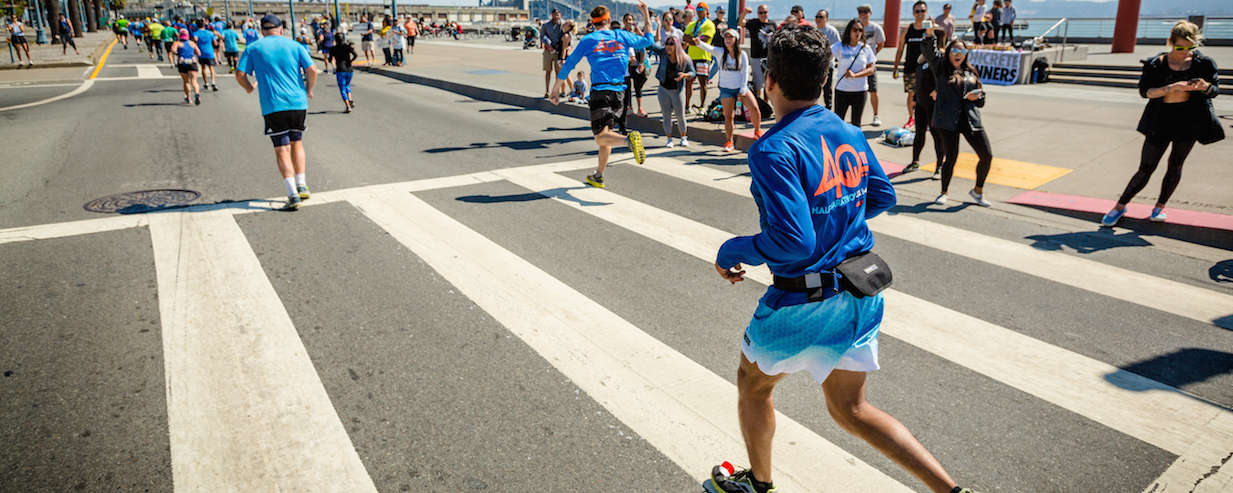Plantar Fasciitis: Problems and Solutions
Now that your training is in high gear, it’s especially important to make sure that you address any aches and pains to avoid any serious injuries. The following blog article comes from Anthony Luke MD, MPH and our Medical Provider partners at RaceSafe.
Don’t forget to sign up for RaceSafe before TSFM (or check to make sure your info is up to date, if you had signed up previously)! Runners are encouraged to complete their RaceSafe profile and share their emergency contacts and pertinent medical details to ensure the UCSF Medical Team can properly treat them if needed on race day.
—
The Starting Line: Why do I have heel pain when I run and what can I do about it?
 Plantar fasciitis is the third most common injury in runners. The fibrous insertion of the plantar fascia into the heel (a.k.a. the calcaneus) is stretched by the repetitive stress of running. Tenderness is often located on the inside aspect of the heel where the arch of the foot ends and the heel contacts the ground. This is a frustrating problem, since it often requires a reduced training period with rest to allow for healing. Stress fractures at the calcaneus, rare nerve issues, and posterior tendon pain are other less common injuries at this location.
Plantar fasciitis is the third most common injury in runners. The fibrous insertion of the plantar fascia into the heel (a.k.a. the calcaneus) is stretched by the repetitive stress of running. Tenderness is often located on the inside aspect of the heel where the arch of the foot ends and the heel contacts the ground. This is a frustrating problem, since it often requires a reduced training period with rest to allow for healing. Stress fractures at the calcaneus, rare nerve issues, and posterior tendon pain are other less common injuries at this location.
Despite it’s high prevalence, there are still limited studies about plantar fasciitis. In one study by Ribeiro et al used a pressure sensor insole to measure forces at the feet of adult recreational runners. They studied 45 runners with plantar fasciitis and 60 healthy controls. The researchers found no difference in the maximum pressure, total contact time, or contact time at the heel between the two groups of runners. This indicates that shock absorption is not necessarily the entire solution to plantar fasciitis – although orthotics and shock-absorbing insoles can help reduce the load over the plantar fascia.
Another study from Pohl, Hamill and Davis analyzed the biomechanical and anatomical factors of the foot in 25 female runners with plantar fasciitis compared to 25 healthy controls. They found that runners with plantar fasciitis displayed a greater force loading rate (how quickly they impacted the ground and how much they loaded maximally), as well as a lower medial arch of the foot.
Two studies, one by DiGiovanni et al in 2003 and a related study in 2006, showed that an 8 week-long plantar fascia stretching program targeting the plantar fascia and the calf helped reduce plantar fascia pain, especially when walking in the morning (a common problem time for those with plantar fasciitis). The improved results lasted for over 2 years, when 92 percent of the study participants still had very satisfactory pain levels and function.
To stretch the plantar fascia specifically, first cross the affected leg over the opposite leg while seated. Apply force on the painful foot by pulling the toes upward toward the shin until you feel a stretch in the sole of the foot. You should feel tension in the plantar fascia while performing this stretch. Hold the stretch for ten seconds and repeat it ten times. The study participants performed these stretches three times per day for 8 weeks. These stretches can be done from bed if the plantar fascia pain is especially bad in the morning.
The Finish Line:
Plantar fasciitis is caused by a combination of foot mechanics, often including tight Achilles and plantar fascia. Addressing flexibility issues and motion at the heel show benefits for plantar fasciitis.
References:
1. DiGiovanni BF, et al. Tissue-specific plantar fascia-stretching exercise enhances outcomes in patients with chronic heel pain. A prospective, randomized study. J Bone Joint Surg Am. 2003 Jul;85-A(7):1270-7. http://www.ncbi.nlm.nih.gov/pubmed/12851352
2. Ribeiro AP, et al. The effects of plantar fasciitis and pain on plantar pressure distribution of recreational runners. Clin Biomech (Bristol, Avon). 2011 Feb;26(2):194-9. Epub 2010 Sep 16. http://www.ncbi.nlm.nih.gov/pubmed/20843589
3. Pohl MB, Hamill J, Davis IS. Biomechanical and anatomic factors associated with a history of plantar fasciitis in female runners. Clin J Sport Med. 2009 Sep;19(5):372-6. http://www.ncbi.nlm.nih.gov/pubmed/19741308
4. DiGiovanni BF, et al. Plantar Fascia-Specific Stretching Exercise Improves Outcomes in Patients with Chronic Plantar Fasciitis: A Prospective Clinical Trial with Two-Year Follow-Up. J Bone Joint Surg Am. 2006 Aug;88(8):1775-81. https://www.ncbi.nlm.nih.gov/pubmed/16882901
Photo credit: TheGiantVermin
*Note: This general information is not intended to be a substitute for medical treatment or advice. Always consult a professional before making changes to your health and wellness practices.


